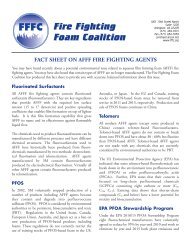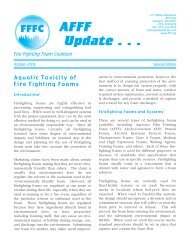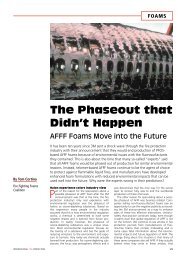P68281 AFFF Update News - The Fire Fighting Foam Coalition
P68281 AFFF Update News - The Fire Fighting Foam Coalition
P68281 AFFF Update News - The Fire Fighting Foam Coalition
You also want an ePaper? Increase the reach of your titles
YUMPU automatically turns print PDFs into web optimized ePapers that Google loves.
<strong>AFFF</strong><strong>Update</strong> . . .2111 Wilson Boulevard8th FloorArlington, VA 22201(703) 524-6636Fax (703) 243-2874cortina@alcalde-fay.comwww.fffc.org<strong>Fire</strong> <strong>Fighting</strong> <strong>Foam</strong> <strong>Coalition</strong>March 2004 Issue 4EPA Workgroup Determines <strong>AFFF</strong>Not a Likely Source of PFOAA workgroup of the U.S. Environmental ProtectionAgency (EPA) has determined that telomer-based<strong>AFFF</strong> is not likely to be a source of perfluorooctanoicacid (PFOA) in the environment and will not have tobe tested in the current enforceable consentagreement (ECA) process. This is very good news forusers of fire fighting foams. It means that the futureof <strong>AFFF</strong> made by current manufacturers is not tied tothe fate of PFOA, as some had speculated in recentyears.<strong>The</strong> decision of the EPA Telomer TechnicalWorkgroup (10/29/03) was based in part on thefollowing information:• Telomer-based <strong>AFFF</strong> agents are not made withPFOA and contain no PFOA-based products.• PFOA is an eight-carbon molecule (C 8 ). <strong>The</strong>majority (over 80%) of the fluorosurfactants usedin telomer-based <strong>AFFF</strong> are derived from sixcarbonmolecules (C 6 ). <strong>The</strong>re is no knownpathway for the C 6 fluorosurfactants used in <strong>AFFF</strong>to break down into PFOA.• Concern that telomer products can break downinto perfluoroalkyl carboxylates such as PFOA isbased on limited data from telomer alcohols inenvironmental and biological systems. <strong>The</strong>fluorosurfactants in telomer-based <strong>AFFF</strong> arederived from telomer iodides, not telomeralcohols. <strong>The</strong>re is no direct evidence that thetelomer iodide-based fluorosurfactants containedin <strong>AFFF</strong> can breakdown in the environment intoPFOA, or its homologues such asperfluorohexanoic acid (PFHA).• <strong>The</strong> known primary breakdown product, basedon the available limited data, is the 6-2 telomersulfonate and not either perfluorohexanoic acid orPFOA.<strong>The</strong> Workgroup, which is evaluating the potential oftelomer products to be future sources of PFOA, ismade up of EPA staff, members of the public, andother interested parties including chemicalmanufacturers and environmental organizations.3M Decision Leads to SpeculationIn May 2000, 3M decided to end production of a lineof products that included <strong>AFFF</strong> because they containand break down into perfluorooctyl sulfonate (PFOS),a chemical the EPA considers to have bothenvironmental and toxicological concerns. PFOSbasedproducts were produced by a unique processcalled electrochemical fluorination (ECF). 3M’sdecision did not have any direct impact on theproduction and availability of other <strong>AFFF</strong> agentsbecause those agents contain fluorosurfactantsproduced by a telomerization process which aregenerally referred to as telomers. Telomer-based -fluorosurfactants neither contain nor breakdown intoPFOS.Ever since 3M announced its decision to endproduction of <strong>AFFF</strong> there has been intensespeculation, fueled by a variety of interest groups, thatother <strong>AFFF</strong> agents would also eventually disappear.This speculation was based largely on the belief thattelomer-based <strong>AFFF</strong> agents could break down in theenvironment into PFOA, and that EPA wouldeventually regulate sources of PFOA as they have forPFOS. In April EPA decided not to take regulatoryaction on PFOA and instead started a public processto generate additional data through an enforceableconsent agreement (ECA). <strong>The</strong> focus of the ECAprocess is not to measure the toxicity of PFOA, but tofind future potential sources of PFOA in theenvironment.
Enforceable Consent AgreementOne of the items proposed in EPA’s initial ECA framework(5/20/03) was an assessment of the potential fortelomer-based fire fighting foams to break down inthe environment into PFOA. EPA’s principal focus forfire fighting foams was the monitoring of sites wherethe foams had been used to look for PFOA or PFOAprecursors. In response to EPA’s ECA framework, the<strong>Fire</strong> <strong>Fighting</strong> <strong>Foam</strong> <strong>Coalition</strong> (FFFC) commissioned aliterature study of available relevant site monitoringdata. FFFC also presented information to the EPATelomer Technical Workgroup on the chemical structureof the fluorosurfactants contained in <strong>AFFF</strong>(9/16/03). Included in this information was the commissionedreport by Dr. Jennifer Field of Oregon StateUniversity on <strong>AFFF</strong> fluorosurfactants in the groundwaterof the fire training areas of three military bases(7/3/03, EPA docket number OPPT-2003-0012-0144).Groundwater MonitoringDr. Field analyzed three military sites where <strong>AFFF</strong> wasused to train fire responders and an area at one ofthese sites where foams were used to put out anactual airplane fire following a crash. <strong>The</strong> sites werethe Naval Air Station Fallon in Nevada, Tyndall AirForce Base in Florida, and Wurtsmith Air Force Basein Michigan, which is also where the plane crashoccurred in 1988.A variety of fluorinated chemicals were found ingroundwater at each location. She broke thefluorinated chemicals into three classes: perfluoroalkylsulfonates, which include PFOS; pefluoroalkylcarboxylates, which include PFOA; and telomersulfonates. Perfluoroalkyl sulfonates ranging fromfour to eight carbons and perfluoroalkyl carboxylatesranging from six to eight carbons were found at allthree locations. Telomer sulfonates, 97-99% with sixcarbons, were found at two of the three locations.Figure 1Telomer BreakdownDr. Field concluded that the perfluoroalkyl sulfonatesand perfluoroalkyl carboxylates came from ECF-based<strong>AFFF</strong> agents and that the telomer sulfonates camefrom telomer-based <strong>AFFF</strong> agents. She also concludedthat there was no evidence from this study thattelomer sulfonates were breaking down in thegroundwater into perfluoroalkyl carboxylates. Basedon their knowledge of the exact chemistry of thetelomer-based <strong>AFFF</strong> agents sold to the military, FFFCscientists have concluded that the telomer sulfonatesfound in the groundwater on military bases are thelikely biodegradation product of the fluorosurfactantactive ingredients in <strong>AFFF</strong> (see Figure 1).Inventory StudyOne of the conclusions that can be drawn from theField report is that the presence of PFOS and PFOAfrom fire fighting foams currently in the environmentmay well be mainly a legacy issue associated with thehistorical use of ECF-based <strong>AFFF</strong>. In order to get ahandle on how much ECF-based <strong>AFFF</strong> is still out inthe field (a current use picture), EPA asked the FFFCto do a study of inventories of ECF-based andtelomer-based <strong>AFFF</strong> in the U.S. FFFC recentlysubmitted a letter to EPA outlining a voluntary <strong>AFFF</strong>inventory study that it expects to complete by June.ConclusionsAqueous film-forming foams are the most effectiveagents currently available to fight hydrocarbon,solvent, and alcohol fuel fires in military, industrial,and municipal settings. Telomer-based foams,manufactured by companies such as Kidde, Ansul,and Buckeye, are not a source of PFOS and areunlikely to be a source of PFOA or its homologues.Now that the biggest perceived threat to thecontinued availability of telomer-based <strong>AFFF</strong> has beendebunked, maybe the speculation about the imminentdemise of <strong>AFFF</strong> will end.Telomer fluorosurfactants in <strong>AFFF</strong> sold to the U.S. military:Precursor - C 6 F 13 CH 2 CH 2 SH normally made from C 6 F 13 CH 2 CH 2 I, or 6-2 Telomer B iodideType of telomer surfactants - All contain group C 6 F 13 CH 2 CH 2 S- or C 6 F 13 CH 2 CH 2 SYCH 2 CH-Degradation products found in groundwater -6:2 telomer sulfonatePerfluorooctyl sulfonate (PFOS)C 6 F 13 CH 2 CH 2 SO 3-C 8 F 17 SO 3- X +Perfluorooctanoic Acid (PFOA)C 7 F 15 CO 2 HPerfluorohexanoic Acid (PFHA) C 5 F 11 CO 2 HConclusion - 6:2 telomer sulfonate is the likely biodegradation product of the C 6fluorosurfactants contained in <strong>AFFF</strong> sold to the U.S. military








